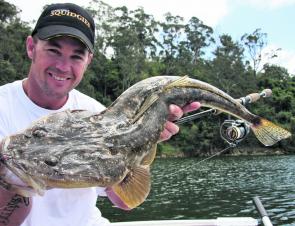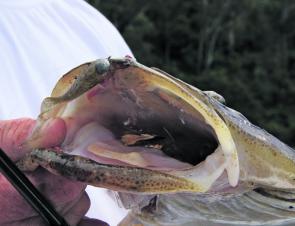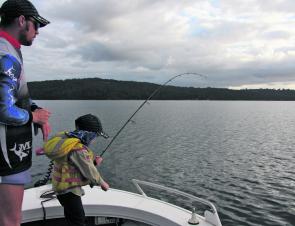All anglers have been under-gunned and lost a battle at some stage during their fishing journeys. Smoked, sizzled and smashed are some of the terminologies you’ll hear during a good fishing story where the fish of the day got away.
Excuses like, ‘I had no chance with this rod’ or ‘My line was too light’ abound.
The truth is, a lot of anglers plunge into a moment of panic when they hear the screaming drag. They may have limited belief in their own ability to play a fish, or lack confidence in their chosen tackle.
The main ingredients to obtaining a worthy light-line capture are patience, self-belief and allowing your gear to do its job, rather than applying your hand to the emptying spool. Stay calm and focused and you just may bring something monumental to the landing net.
Finesse gear and ultra-light tactics can trigger a strike when a bite has shut down. Tournament anglers regularly know this and often start light for improved catch rates.
Fishing with light line produces many hurdles but the biggest is locking horns with a much larger adversary than the original target. For example, croc-sized flathead and big mulloway can take very small lures intended for bream.
So what happens if you do pin something large? Do you admit defeat before the fight begins, believing you don’t stand a chance?
In most cases, an angler will lapse into shock and stare at the emptying spool wondering what to do, rather than acting fast.
Big fish are regularly hooked on light gear and you can beat them if you keep your wits about you.
The battle rests on the reel’s line capacity (always keep your spool full), smooth drag (keep gear in top nick), strong knots (retie knots regularly to reduce fatigue) and a solid hook-set. Keep focused for early detection of bites to avoid deep hooking and where possible, chase the hooked fish.
Big fish often take a while to realise they are hooked and initially tend to pussyfoot around on light line.
These antics can deceive the angler into thinking they have hooked an average-sized fish but it is this stage where an angler needs to assume the fish is large and get the jump on their opponent.
The less pressure you place on the fish, the less it reacts. This is the best scenario for the angler because the fish is spending energy with limited stress on your terminal tackle and knots.
Your best chance of beating the fish is to lead it to open water and attempt to keep it there by limiting the amount of pressure you place on it.
By staying close, keeping a soft pair of hands and a light drag setting, you are able to lead the fish around like a puppy.
The moment you are heavy-handed with a big fish is precisely when you’ll feel its full power and this is bad news!
Notice the direction the fish favours after a bustling run; it may indicate which side of the mouth it is hooked. If the fish arcs to your left after a sudden burst, you can assume it is tethered by the left side of its mouth, and vice-versa.
Once you are confident you have established the side of the hook-set, you need to keep your boat on that side of the fish during the chase. This ensures the line won’t wrap around the fish or, worse, run across the fish’s mouth.
If the fish spooks, generally from excessive angler pressure, and turns and runs the other direction, you must back off the drag immediately and manoeuvre your boat quickly into the correct fighting position before reapplying pressure.
You may have to repeat this process a number of times so remain calm.
I’ve seen anglers fight a fish on light line for an eternity, only to lose patience in the dying stages and lose the fish.
Two factors can bring many anglers undone during the final round of an epic encounter.
Firstly, the angler finally gets sight of their prize and the sudden rush of blood makes them feverishly try to drag the fish to the landing net. Big mistake!
You must stay on your game and prepare for anything the fish throws at you. All the good work comes undone when you panic or concentration fades.
Play it cool until the fish is lying motionless at the surface with its head pointing in the direction of the net and then gently slide it in. (Especially for big flathead, try to avoid lifting the fish’s head right to the surface, it’ll surely shake its head and could sever the leader or throw the hook. – Editor)
Secondly, the landing net operator could have a complete shocker. I bet you have all had a handy mate on the landing net during this vital stage.
Trying to caress the fish with the net sub-surface is a difficult and dangerous move. If the fish sees or touches the net, it’s outta there!
Let the angler lead the fish to the net; the angler will have a better idea of the fish’s movements.
Once the fish’s head is well over the net, a calm, graceful lift is all that is required. Don’t use an overhand swat, we’re not catching butterflies.
Never touch the angler’s line during the netting process; it usually results in a lost fish and the angler will remind you of your evil deed forever!
Diagram
Figures 1 & 2
The angler tracks the fish whilst remaining on the same side as the hook-set.
Figure 3
The angler gently leads the fish away from structure to the safety of open water.
Figure 4
An example of a fish changing direction, increasing the risk of the leader rubbing on the fish’s gills and teeth.
Figure 5
Correcting your fighting position – back your drag off during this process.
Reads: 5287
The author was fishing Squidgy Wrigglers for bream on 3lb leader when he felt the clunk of a solid fish. Manoeuvring the boat and hovering over the fish during the whole fight avoided the leader rubbing across the fish’s mouth and 83cm of flathead was the

Staying focused on information transmitted through braided line allowed the author to strike early and avoid deeply hooking this fish. The hook found a safe location in this big gob.

Trudi Badullovich was ecstatic to win the battle with this 8.7kg mulloway on bream gear and 4lb leader. She and the author followed the fish with the electric motor for 22 minutes and it came within netting range several times. Each opportunity was aborte

The author’s son Clayton locked in battle with a big tailor while the author manoeuvres the boat with the electric motor. In this case the boat was kept to the fish’s left side because its behaviour after hook-up indicated it was hooked in the left of the

Clayton’s 91cm tailor had the lure in the left side of its mouth. Early detection of this aided in the fight and helped guide it to the net.




